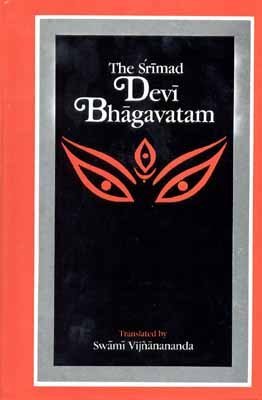The Devi Bhagavata Purana
by Swami Vijñanananda | 1921 | 545,801 words | ISBN-10: 8121505917 | ISBN-13: 9788121505918
The English translation of the Devi Bhagavata Purana. This Sanskrit work describes the Devi (Divine), the Goddess, as the foundation of the world and as identical with Brahman, the Supreme Being. The Devi Bhagavata Purana is one of the most important works in Shaktism, a branch of Hinduism focusing on the veneration of the divine feminine, along w...
Chapter 3 - On the description of the Kavaca of Śrī Gāyatrī Devī
1-3. Nārada spoke :-- O Bhagavān! Thou art the Lord of this world; Thou canst shew favour and disfavour both; Thou art specially versed in the sixty-four Kalās (arts of learning); Thou art the chief of the Yogis. I therefore ask Thee to solve a doubt of mine. By what Puṇyam a man can become free from all his sins and limitations and he can realise and become of the nature of Brahmā. O Lord! And what are duly the Ṛṣis, Caṇdas, Devatās, Dhyān, and Nyāsa, etc., of this meritorious act? I want to hear.
4-25. Nārāyaṇa said :-- O Nārada! There is but one and the only one way to this and though that is very secret, I will disclose that to you. It is the Gāyatrī-Kavaca. It can destroy all sins. Therefore to recite or to hold it on one’s body enables the man to become free from all his sins and to get all his desires fulfilled and he gets the Sāyuya Mukti with the Devī (be merged in the Devī-Body). Now hear the Ṛṣis, Caṇdas, etc.
, of this Kavaca :-- Brahmā, Viṣṇu and Maheśvara are the Ṛṣis; the Rik, Yajus, Sāma and Atharva Vedas are the Caṇdas; the Paramā Kalā Gāyatrī of the nature of Brahmā is the Devatā; “Tat” in Gāyatrī is the Vīja; “Bharga” is the Śakti; and “Dhīyah” is the Kīlaka; and its viniyoga (application) is in getting the Mokṣa (liberation.). With the first four syllables touch the heart; with the next three letters touch the head; with the next four letters touch the tuft on the crown of the head; with the next three letters on the Kavaca; with the next four letters on the eyes and with the last four letters make the Nyāsa, all over the body repeating “Astrāya Phaṭ,” O Nārada! Hear now the Dhyānam of Gāyatrī, that grants all desires. The Gāyatrī Devī has five faces; one of which is of white colour; and the other four is of pearl, Vidruma, golden, and Nīlakāntamaṇi colour respectively. Each face has got three eyes; on the head there is a crown of jewels and the digit of the Moon is shining there. Her body is composed of the twenty-four tattvas.
She has ten hands :-- On the top right and left hands there are two lotuses; lower down, there are disc and conch shell; lower down, there are rope and skull; lower down, there are noose and goad; and on the bottom hands right and left she is making signs of “No fear” and “ready to grant boons.”
Thus meditating on Śrī Gāyatrī, one is to recite the Kavaca thus :-- Let the Gāyatrī Devī protect my front; Sāvitrī Devī protect my right; the Sandhyā Devī, my back and the Devī Sarasvatī, my left. Let my Mother Pārvatī Devī protect my quarters. Let Jalaśāyinī protect the southeast; Yātudhāna Bhayankarī protect my South-west; Pavamānavilāsinī my north-west; Rudrarūpiṇī Rudrāṇī protect my north-east. Let Brahmāṇī protect my top and Vaiṣṇavī protect my nether regions. Let the word “Tat” in the Gāyatrī protect my legs; “Savituḥ” protect my Knees; “Vareṇyam,” protect my loins; “Bhargah,” my navel. Let “Devasya” protect my heart; “Dhīmahī” protect my neck; “Dhīyah,” protect my eyes; “Yah,” protect my forehead; “Naḥ” protect my head; and “Pracodayāt” protect the tuft on the crown of my head.
Again let the “Tat” of the twenty-four syllabled Gāyatrī protect my head; “Sa,” protect my forehead; “Vi” protect my eyes; “Tu” my cheeks; “Va,” protect my nostrils; “Re,” my mouth; “ṇi” protect my upper lip; “Yaḥ” protect my lower lip; “Bha” within my face; “rgo,” protect my cheeks; “De,” my throat; “Va” my shoulders; “Sya” my right hand; “Dhi” my navel; “ma,” my heart, “Hi,” my belly; “Dhī,” my navel; “Yo” my loins; “Yo”, my anus; “naḥ,” my thighs, “Pra,” my Knees; “Cho” my shanks “Da” my heels; “Yā” my legs; and let “at” protect all my sides. O Nārada! This divine Kavaca of the Devī Gāyatrī can baffle hundreds and thousands of obstructions and evils; can grant sixty-four Kalās and liberation. By the glory of this Kavaca, man can become free from all evils and can attain the state of Brahmā. Moreover whoever reads or hears this acquires the fruits of making a gift of a thousand cows.
Here ends the Third Chapter of the Twelfth Book on the description of the Kavaca of Śrī Gāyatrī Devī in the Mahāpurāṇam Śrī Mad Devī Bhāgavatam of 18,000 verses by Maharṣi Veda Vyāsa.
